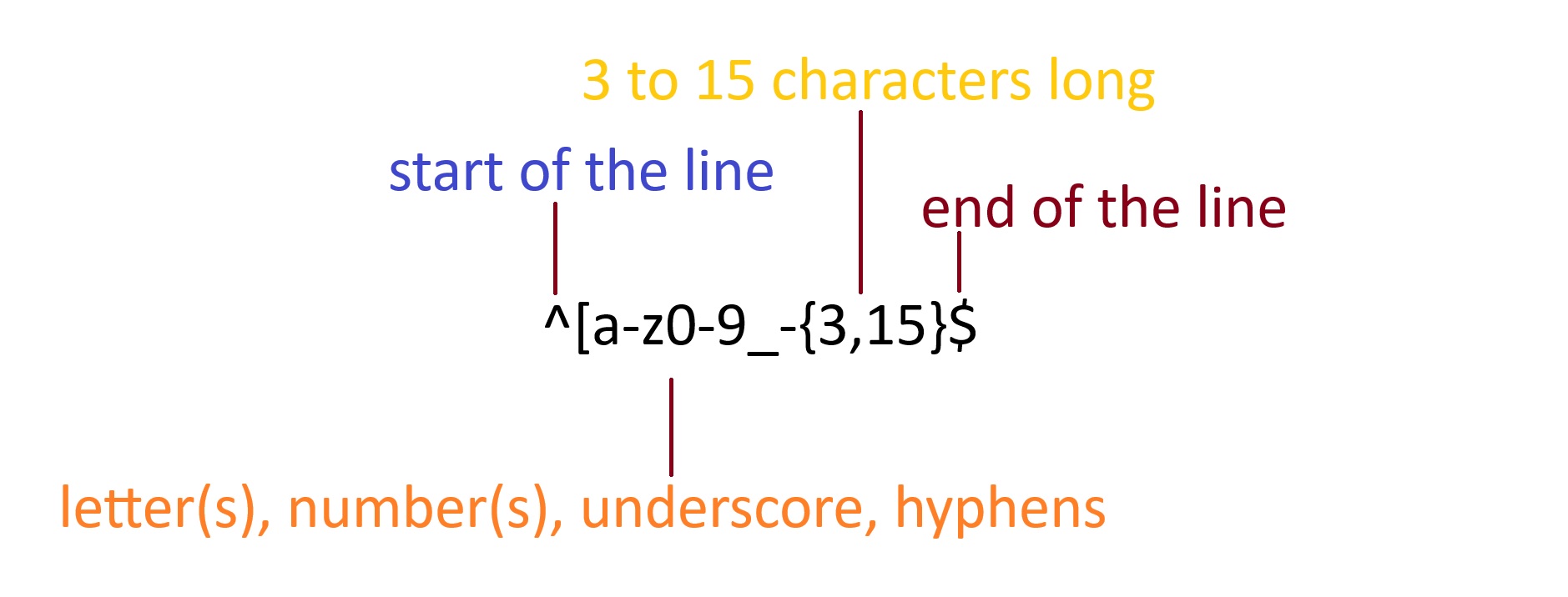
What are Regular Expressions?
Regular expression is a group of characters or symbols which is used to find a specific
pattern from a text.
A regular expression is a pattern that is matched against a subject string from left to right.
The word "Regular expression" is a
mouthful, you will usually find the term abbreviated as "regex" or "regexp". Regular expression
is used for replacing a text within
a string, validating form, extract a substring from a string based upon a pattern match, and so
much more.
Imagine you are writing an application and you want to set the rules for when a user chooses
their username. We want to
allow the username to contain letters, numbers, underscores and hyphens. We also want to limit
the number of
characters in username so it does not look ugly. We use the following regular expression to
validate a username:
 Above regular expression can accept the strings john_doe, jo-hn_doe
and john12_as. It does
not match Jo because that string
contains uppercase letter and also it is too short.
Above regular expression can accept the strings john_doe, jo-hn_doe
and john12_as. It does
not match Jo because that string
contains uppercase letter and also it is too short.
Why are Regular Expressions Important in Web Development?
Regular expressions play a crucial role in web development by enabling developers to
validate, extract,
and manipulate textual data efficiently. They are used for tasks like form validation, data
validation,
parsing, and more.
Decoding the Strong Password Regex
In today's digital age, the security of our online accounts and personal information is
paramount. One of the fundamental ways to safeguard our online presence is by using strong and
secure passwords. To enforce the creation of strong passwords, websites and applications often
employ regular expressions (regex) to define specific criteria that passwords must meet. In this
article, we will delve into the concept of strong password regex patterns, understanding their
necessity, exploring common patterns, and defining the criteria for a strong password.
Understanding the Need for Strong Passwords
In the realm of cybersecurity, weak passwords are akin to leaving the front door of your
house wide open. Cyber attackers employ various methods to crack weak passwords and gain
unauthorized access to accounts. This is where the importance of strong passwords comes into
play. A strong password is one that is complex, difficult to guess, and resistant to brute-force
attacks.
A week password most likely to be a word that is in the dictionary, or
a common word followed by a simple number sequence. like password123 or 123456
A strong password is one that is complex, difficult to guess, and resistant to
brute-force attacks. like pass@1word!$*/ and so on.
Exploring the Strong Password Regex Pattern
This section introduces the regex pattern for strong passwords that you'll be
dissecting throughout the
tutorial. It prepares you for understanding the various components and criteria of the
pattern.In the following example of password regex pattern, you'll notice a combination of
letters, numbers, and special characters. I know it feels like hakuna matata stuff but don't worry
we will break it down.
/^(?=.*[0-9])(?=.*[a-z])(?=.*[A-Z])(?=.*\W)(?!.* ).{8,}$/

Analyzing Each Component
You'll delve into the specific requirements that define a strong password, such as
length, character
combination, and the inclusion of special characters. These criteria contribute to a more
secure
authentication process. Let's take a closer look at each of these components.
Minimum Length Requirement
To ensure the strength of passwords, a common practice is to set a minimum length requirement. This
means that
passwords must contain a certain number of characters to be considered strong. In the example pattern
below,
the {8,} specifies that the password must be at least 8 characters long.
/^(?=.*[0-9])(?=.*[a-z])(?=.*[A-Z])(?=.*\W)(?!.* ).{8,}$/
In this case as you can see the highlighted part of the regex pattern is .{8,} which
means
that the password must be at least 8 characters long. If you want to set a maximum length for the
password, you can use .{8,16} which means that the password must be at least 8
characters
long and can't be longer than 16 characters.
Combination of Characters
Strong passwords often require a combination of different character types, such as uppercase letters,
lowercase letters, digits, and special characters. This diversity increases complexity and security. The
example pattern below enforces a combination of these character types.
/^(?=.*[0-9])(?=.*[a-z])(?=.*[A-Z])(?=.*\W)(?!.* ).{8,}$/
and all these highlighted parts of the regex pattern are the conditions for the password which
combine all characters. The password
must contain at least one digit, one lowercase letter, one uppercase letter, and so on.
Including Special Characters
Special characters like symbols and punctuation marks add an extra layer of security to passwords. These
characters are often harder to guess and can thwart various hacking attempts. The example pattern below
ensures the inclusion of at least one special character.
/^(?=.*[0-9])(?=.*[a-z])(?=.*[A-Z])(?=.*\W)(?!.* ).{8,}$/
here \W refers to any non-word character. It matches any character that is not a
word character from the basic Latin alphabet. Equivalent to [^A-Za-z0-9_]. which means
that the password must contain at least one special character.
Constructing the Complete Pattern
Now that you've explored the individual components of a strong password regex pattern, it's time
to put
them
all together. The following complete pattern combines the criteria for a strong password, including
minimum
length, a variety of character types, and the presence of special characters. This pattern can be used
to
validate strong passwords.
/^(?=.*[0-9])(?=.*[a-z])(?=.*[A-Z])(?=.*\W)(?!.* ).{8,16}$/
And now we have a complete regex pattern for strong passwords. This pattern can be used to validate
strong passwords.
Application in Real Projects
Understanding regex patterns for strong passwords is essential for enhancing security in various
applications.
Whether you're developing a registration form, user account system, or any other scenario requiring
secure
password creation, applying this regex pattern can greatly improve the resilience of your system against
common password-related vulnerabilities.
Real-World Example of Strong Password Regex Pattern
Let's explore a real-world example of a strong password regex pattern used in an application:
Consider the following JavaScript code snippet:
function validatePassword() {
// Get the value entered in the password input field
const passwordInput = document.getElementById('passwordInput').value;
// Define a regex pattern for strong passwords
const regex = /^(?=.*[A-Za-z])(?=.*\d)(?=.*[@#$%^&!])[A-Za-z\d@#$%^&!]{8,}$/;
// Test the entered password against the regex pattern
if (regex.test(passwordInput)) {
// Display a success message if the password is valid
document.getElementById('validationResult').textContent = 'Password is valid!';
document.getElementById('validationResult').style.color = 'green';
} else {
// Display an error message if the password is invalid
document.getElementById('validationResult').textContent = 'Password is invalid!';
document.getElementById('validationResult').style.color = 'red';
}
}
This code constructs a regex pattern that enforces a strong password policy, including minimum and
maximum
length, required uppercase and lowercase letters, numerics, and special characters. It's a practical
example of
how regex patterns can be applied in real-world applications for enhanced password security.
test
Summary
I want to remind you of some basic rules of regex patterns before I summarize this article.
Be careful with these rules:
- indicate '^' at the beginning of the string. indicate '$' at the end of
the string.
If we don't use these ^ & $, the regex will not be able to determine the maximum length of the
password.
In the above example, we have a condition that the password can't be longer than 16 characters.
To
make
that condition work, we have used these ^ & $.
- Remove maximum length restriction: Instead of
.{8,16}, if we used
.{8,},
it would mean that the password must be at least 8 characters long. So, there will not be any
condition for
checking the maximum length of the password.
- Don't accept any number (digit): Instead of
(?=.*[0-9]), if we
used
(?!.*[0-9]),
it would mean that the password must not contain any digit from 0 to 9 (Difference with the
(?=.*[0-9]) is
the use of ! instead of =).
- Don't accept any special character: Instead of
(?=.*\W), if we
used
(?!.*\W),
it would mean that the password must not contain any special characters (The difference with the
(?=.*\W) is
the use of ! instead of =).
- Alternative Syntax for number (digit): Instead of
(?=.*[0-9]), we
could have used
(?=.*\d). (?=.*\d) also means that the password must contain a single
digit from 0 to 9.
So, that's all for this article. I hope you have understood the concept of strong password regex pattern. Thanks for reading.
×
About the author
My name is Solomon Tegegne I am currently student @ University of Utah Coding Bootcamp. I am
a full-stack web developer. you can find me on the following social media.








